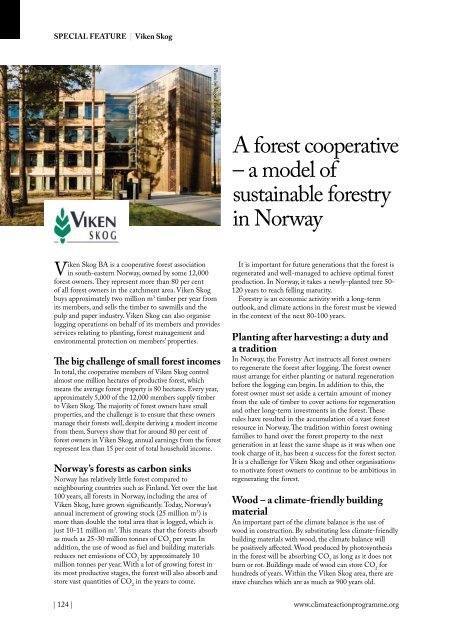Climate Action 2010-2011
You also want an ePaper? Increase the reach of your titles
YUMPU automatically turns print PDFs into web optimized ePapers that Google loves.
SPECIAL FEATURE | Viken Skog<br />
Photo by Vegard Breie.<br />
A forest cooperative<br />
– a model of<br />
sustainable forestry<br />
in Norway<br />
Viken Skog BA is a cooperative forest association<br />
in south-eastern Norway, owned by some 12,000<br />
forest owners. They represent more than 80 per cent<br />
of all forest owners in the catchment area. Viken Skog<br />
buys approximately two million m 3 timber per year from<br />
its members, and sells the timber to sawmills and the<br />
pulp and paper industry. Viken Skog can also organise<br />
logging operations on behalf of its members and provides<br />
services relating to planting, forest management and<br />
environmental protection on members’ properties.<br />
The big challenge of small forest incomes<br />
In total, the cooperative members of Viken Skog control<br />
almost one million hectares of productive forest, which<br />
means the average forest property is 80 hectares. Every year,<br />
approximately 5,000 of the 12,000 members supply timber<br />
to Viken Skog. The majority of forest owners have small<br />
properties, and the challenge is to ensure that these owners<br />
manage their forests well, despite deriving a modest income<br />
from them. Surveys show that for around 80 per cent of<br />
forest owners in Viken Skog, annual earnings from the forest<br />
represent less than 15 per cent of total household income.<br />
Norway’s forests as carbon sinks<br />
Norway has relatively little forest compared to<br />
neighbouring countries such as Finland. Yet over the last<br />
100 years, all forests in Norway, including the area of<br />
Viken Skog, have grown significantly. Today, Norway’s<br />
annual increment of growing stock (25 million m 3 ) is<br />
more than double the total area that is logged, which is<br />
just 10-11 million m 3 . This means that the forests absorb<br />
as much as 25-30 million tonnes of CO 2<br />
per year. In<br />
addition, the use of wood as fuel and building materials<br />
reduces net emissions of CO 2<br />
by approximately 10<br />
million tonnes per year. With a lot of growing forest in<br />
its most productive stages, the forest will also absorb and<br />
store vast quantities of CO 2<br />
in the years to come.<br />
It is important for future generations that the forest is<br />
regenerated and well-managed to achieve optimal forest<br />
production. In Norway, it takes a newly-planted tree 50-<br />
120 years to reach felling maturity.<br />
Forestry is an economic activity with a long-term<br />
outlook, and climate actions in the forest must be viewed<br />
in the context of the next 80-100 years.<br />
Planting after harvesting: a duty and<br />
a tradition<br />
In Norway, the Forestry Act instructs all forest owners<br />
to regenerate the forest after logging. The forest owner<br />
must arrange for either planting or natural regeneration<br />
before the logging can begin. In addition to this, the<br />
forest owner must set aside a certain amount of money<br />
from the sale of timber to cover actions for regeneration<br />
and other long-term investments in the forest. These<br />
rules have resulted in the accumulation of a vast forest<br />
resource in Norway. The tradition within forest owning<br />
families to hand over the forest property to the next<br />
generation in at least the same shape as it was when one<br />
took charge of it, has been a success for the forest sector.<br />
It is a challenge for Viken Skog and other organisations<br />
to motivate forest owners to continue to be ambitious in<br />
regenerating the forest.<br />
Wood – a climate-friendly building<br />
material<br />
An important part of the climate balance is the use of<br />
wood in construction. By substituting less climate-friendly<br />
building materials with wood, the climate balance will<br />
be positively affected. Wood produced by photosynthesis<br />
in the forest will be absorbing CO 2<br />
as long as it does not<br />
burn or rot. Buildings made of wood can store CO 2<br />
for<br />
hundreds of years. Within the Viken Skog area, there are<br />
stave churches which are as much as 900 years old.<br />
| 124 |<br />
www.climateactionprogramme.org












